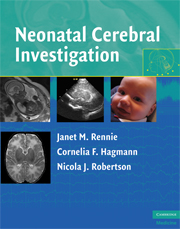Book contents
- Frontmatter
- Contents
- List of contributors
- Preface
- Acknowledgements
- Glossary and abbreviations
- Section I Physics, safety, and patient handling
- Section II Normal appearances
- 4 Normal neonatal imaging appearances
- 5 The immature brain
- 6 The normal EEG and aEEG
- Section III Solving clinical problems and interpretation of test results
- Index
- References
6 - The normal EEG and aEEG
from Section II - Normal appearances
Published online by Cambridge University Press: 07 December 2009
- Frontmatter
- Contents
- List of contributors
- Preface
- Acknowledgements
- Glossary and abbreviations
- Section I Physics, safety, and patient handling
- Section II Normal appearances
- 4 Normal neonatal imaging appearances
- 5 The immature brain
- 6 The normal EEG and aEEG
- Section III Solving clinical problems and interpretation of test results
- Index
- References
Summary
Neonatal EEG: general features
The EEG of the newborn baby is unique. Patterns of electrical activity are seen that mirror the rapid maturational changes taking place in the brain. Waveforms appear that are not present at any other time of life. Sleep states are varied, change rapidly, and are very different from those seen in older children and adults.
The EEG of the neonate is best described in terms of the background activity or pattern. This is the baseline activity of the brain at rest, during wakefulness or sleep.
The EEG patterns of the full-term and of the preterm neonate are very different and it is best to consider them separately. However, the features used to describe the background activity are similar. The background activity of the neonatal EEG is generally described in terms of the following features: continuity, amplitude, frequency, synchrony and symmetry, maturational characteristics, state differentiation, and reactivity.
Continuity
The EEG of the normal full-term newborn shows continuous activity. This simply means that there is activity with a measurable voltage or amplitude present at all times (Fig. 6.1a). In contrast, preterm newborns exhibit a discontinuous EEG pattern (tracé discontinu) which is characterized by periods of continuous activity alternating with periods of little or no measurable voltage quiescence (Fig. 6.1b). In extremely preterm babies the EEG is very discontinuous and periods of quiescence can last up to 60 seconds. The EEG becomes progressively more continuous with increasing gestational age.
- Type
- Chapter
- Information
- Neonatal Cerebral Investigation , pp. 83 - 91Publisher: Cambridge University PressPrint publication year: 2008
References
- 7
- Cited by



